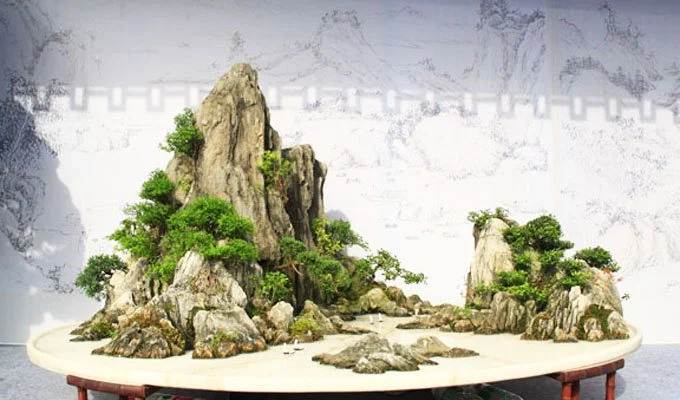Art - Penjing: A Journey into Miniature Worlds
For centuries, the ancient art of Penjing has captivated hearts with its ability to transform nature into a miniature, mystical world. Originating in China over 1,300 years ago, Penjing—translated as "pot scenery"—is the precursor to the Japanese bonsai. In fact, Buddhist monks from China brought the art form to Japan! While both art forms involve cultivating and shaping miniature trees, Penjing encompasses a broader, more expressive approach. It’s a creative practice steeped in history, philosophy, and artistry, offering not only aesthetic pleasure but also profound mental health benefits.
What is Penjing?
Penjing is more than a horticultural craft; it is a form of living art. Artists create miniature landscapes that often include trees, rocks, water, and figurines, all arranged to convey a story or evoke a specific mood. Unlike bonsai, which focuses primarily on the beauty and structure of a single tree or a small grouping, Penjing embraces the concept of an entire natural scene, which can take on various styles that highlight its diversity and artistry. For example, the landscape style focuses on recreating expansive terrains with mountains, rivers, and forests, while the tree-focused style emphasizes the beauty of individual or grouped miniature trees. Another popular approach is the water-and-land style, which integrates water elements like ponds or streams, adding a dynamic and serene quality to the composition.
The artistry of Penjing lies in its ability to replicate the grandeur of nature within a confined space. Each element—from the twisted trunk of a tree to the placement of a tiny bridge—is carefully chosen to evoke feelings of harmony, mystery, and balance. The goal is not just to mimic nature but to distill its essence, inviting viewers to lose themselves in a tranquil, meditative moment.
How Penjing Differs from Bonsai
Although Penjing and bonsai share similarities, they differ in philosophy, technique, and scope:
Philosophy:
Penjing emphasizes storytelling and artistic expression. It often includes dramatic, exaggerated features designed to invoke emotional responses.
Bonsai, on the other hand, leans towards simplicity and restraint, focusing on the meticulous refinement of tree shapes to reflect natural beauty.
Elements:
Penjing integrates multiple elements like rocks, water, and figurines to create an entire scene. For example, a Penjing composition might depict a mountain village surrounded by a serene river and ancient trees.
Bonsai is typically centered on a single tree or a small grouping, with minimal additional elements.
Aesthetic Principles:
Penjing embraces asymmetry and wildness, mirroring the unpredictability of nature.
Bonsai follows strict rules of proportion, symmetry, and simplicity, reflecting its Japanese cultural origins of discipline and order.
Scale and Scope:
Penjing compositions can be larger and more elaborate, encompassing vast landscapes on a single tray.
Bonsai tends to be smaller, focusing solely on the tree’s refinement.
Mental Health Benefits of Penjing
Engaging in Penjing offers more than artistic satisfaction; it provides numerous mental health benefits that make it an ideal pastime for individuals seeking peace and mindfulness. Creating these intricate scenes requires patience, attention to detail, and a deep connection with nature—qualities that promote mental well-being.
Stress Reduction: The act of shaping and nurturing a Penjing scene is inherently calming. It encourages mindfulness as you focus on each small detail, leaving behind daily worries and distractions.
Enhanced Creativity: Penjing’s freedom of expression allows artists to imagine and create unique worlds. This creative outlet can help reduce anxiety and promote a sense of accomplishment.
Connection with Nature: Even in urban settings, Penjing offers a way to reconnect with the natural world. Tending to the trees and arranging elements fosters a sense of grounding and harmony.
Meditative Practice: The slow, deliberate process of designing and maintaining a Penjing composition can be meditative. It encourages a state of flow, where time seems to stand still, and mental clarity emerges.
How to Get Started with Penjing
Starting your own Penjing creation doesn’t require prior experience—just a willingness to learn and experiment. Here are a few steps to guide you:
Choose a Theme: Decide on the type of landscape you want to create. Will it be a peaceful mountain retreat, a bustling village, or a tranquil riverside?
Gather Materials: Collect a shallow tray, soil, rocks, and plants suitable for miniaturization. You can also include figurines or structures to bring your scene to life.
Learn the Basics: Study the principles of tree shaping, rock placement, and balance. There are many resources, workshops, and online tutorials available to help.
Embrace the Process: Remember, Penjing is as much about the journey as the final result. Enjoy the creative process and allow your imagination to guide you.
Penjing is more than an art form; it’s a pathway to mindfulness, creativity, and inner peace. By crafting miniature worlds, you can immerse yourself in nature’s beauty, find solace in its serenity, and experience the joy of creation. Whether you’re a seasoned gardener or a curious beginner, Penjing offers a fulfilling way to cultivate not just landscapes, but also a sense of well-being.
